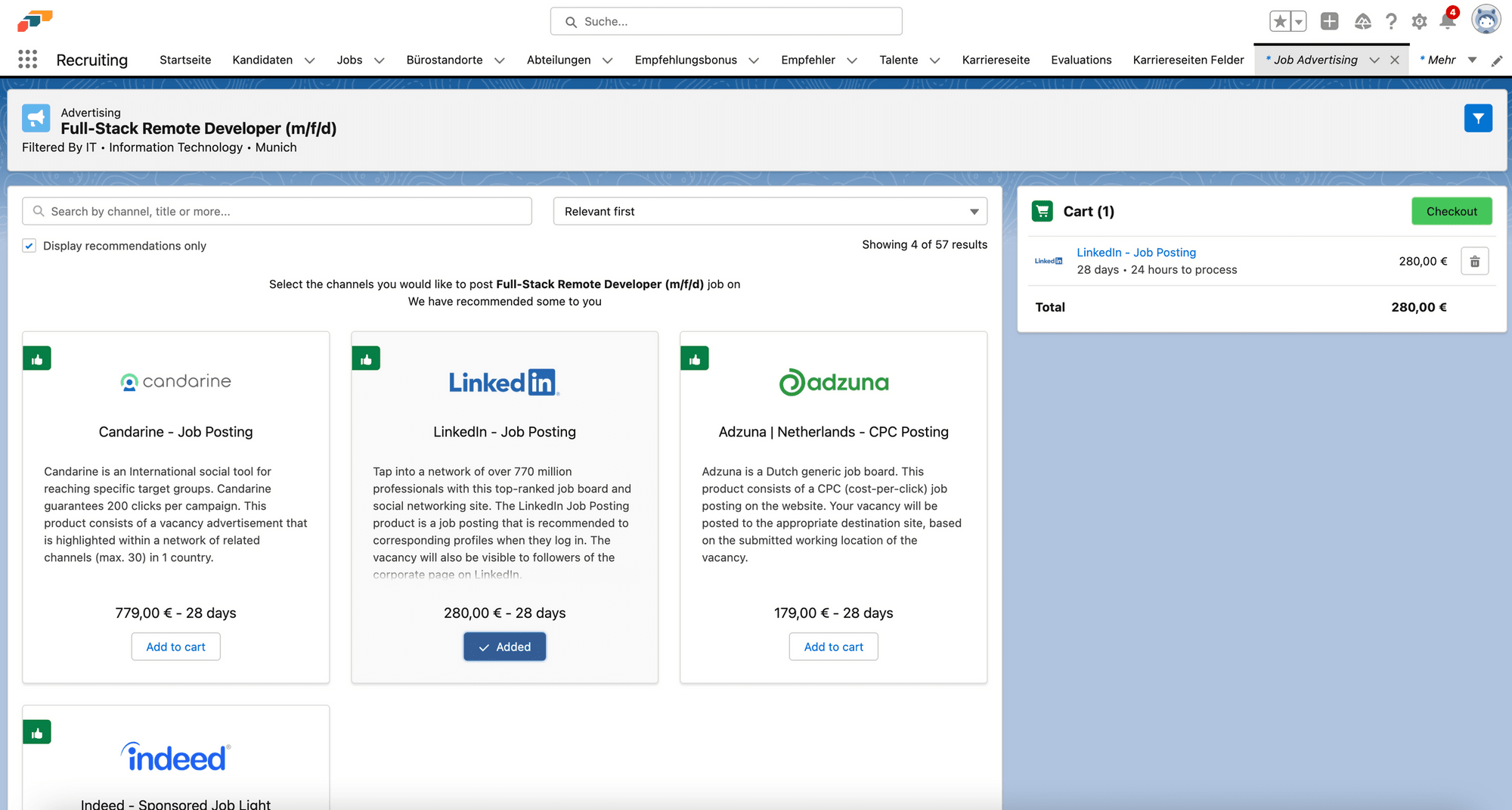100 Job Interview Statistics: First Impressions and Interview Processes
Master your next job interview with expert tips and statistics that will boost your confidence and impress potential employers.
- 16 Apr 2024
- Max 13 min read
The Number One HR Solution on Salesforce
Social media has become an essential part in the process of finding the ideal candidates. This practical guide gives you a few tips for implementing your own social media recruiting strategy.
Today, not only can you find job postings on online job boards but also on social media networks such as Linkedin, Instagram, and Facebook. In modern recruitment, social media channels have become an effective way to find high-quality candidates. Today’s job listings involve much more than a simple job description.
Social recruiting, also known as social hiring or social media recruitment, describes all the recruitment marketing processes performed on social media. Companies use platforms such as LinkedIn, Twitter, Instagram, and Facebook to appeal to potential candidates. Ideally, they can use a range of ongoing initiatives to establish a pool of top talent.
Professional networks are beneficial in creating an appealing employer brand and filling open positions with qualified candidates. But social recruiting is about more than just posting jobs on social media. It is a digital recruiting strategy that includes cultivating business networks, sharing content on industry-relevant topics, and positioning the company as an attractive workplace in the war for talent.
Which channel you should use depends heavily on the age of your target candidates. A well-made TikTok or Snapchat video might help you win over millennials and generation Z. However, these platforms are unlikely to help you reach suitable candidates from the baby boomer generation.
Thanks to digitalization and demographic changes, the recruitment process is more diverse than ever. It requires an innovative and creative strategy. Strategic content marketing is the best way to prepare for this challenge. The content that a company shares on its social media channels needs to be more than just relevant; it also needs to align with its values.
There is fierce competition for top talent. A company that neglects to include the major social media platforms in its talent acquisition strategy will struggle to attract the best candidates. But even companies who have recognized the trend often lack the necessary skills, capacity, and strategy to follow it.
It’s no longer enough to simply reuse an existing job ad and post it on any old job board. You should be aware of the power of social media. Over 84% of the population in Western and Northern Europe use social media. From this, we can conclude that almost every person of working age in these regions has a social media account.
80% of users are active on these channels daily. This makes them some of the most visited websites on the internet.
That’s why you should follow recruiting trends and define what they mean to your company in the search for new employees. While the benefits of social recruiting clearly outweigh the potential risks, keeping both sides in mind is important.

Here’s a summary of the benefits:
The challenges of social recruiting mostly relate to finding the right way to communicate with suitable candidates. Here are some ways to avoid making mistakes in social recruiting efforts:
In social recruiting, there are different methods for filling open positions with suitable candidates and counteracting the skills shortage.
One important aspect is employer branding. It goes hand in hand with a content plan that addresses your target audience. If you run a SaaS company, make sure to work with a content marketing agency for SaaS to get the content planning and creation done at a strategy level.
Furtermore, a content strategy helps you increase awareness among your target audience and generate organic growth, without the need for paid ads. More relevant content means more engagement. Therefore, sooner you start to scale ai content with relevancy, sooner you will see the worthy results.
Another important point in social media recruiting is active sourcing: a method where HR teams proactively approach promising candidates to generate interest in the company. Using data, you can make a preselection to filter out suitable candidates.
You can also spread the word about open positions with the help of influencers who are known and trusted in your industry and can act as a multiplier for your message. There are influencers in all kinds of industries, and it’s important to recognize the impact these leading voices can have.
Having a well-designed careers page on your company website is essential. You should ensure it includes your brand logo and conveys the right company message. For this, consider using a professional logo maker, generate a good slogan for your brand, and consult with a branding expert. Your social media pages and paid ads should link to this page, as active job seekers inform themselves about a potential new job before speaking to companies.
You should carefully plan your company profile on business networking platforms like LinkedIn to ensure that it comes across as professional, authentic, and valuable. Active job seekers use these platforms every day. This makes it all the more important to differentiate yourself from competitors and use high-quality content to attract talent.
flair can help you simplify and streamline the application process across platforms and job sites, making it easier for you to monitor.

LinkedIn is designed for business networking. In addition to looking for jobs, users can find content relevant to their field of work. On platforms like LinkedIn, you have a higher chance of finding people interested in your job offers. Moreover, you can view a candidate’s qualifications and previous jobs, helping you gain insight into their skills and experience. This can be very helpful in the hiring process. The trick is to work on your employee value proposition to differentiate yourself better and attract talent.
When searching for candidates on LinkedIn, you can use an advanced search with filters to hone in on the right people. In many cases, these tools eliminate the need for a cover letter or CV and enable you to start a conversation with promising candidates immediately.
To make the best start, you should first define the goals you want to achieve through social media recruitment. You can then enter these goals into an OKR (objectives and key results) framework.
This first step is necessary to enable the success of your social recruiting. It can help to seek the advice of experienced team members to develop the strategy. If your company lacks the necessary knowledge, it can be a good idea to seek support from external sources. As candidates spend a lot of time on social media and business networks, your job ads must be well-planned and strategically distributed to attract their attention. For this, you can consider the help of an experienced Facebook ads agency or a special platform expert.
Every channel you use for social recruiting needs its own strategy and dedicated resources. When choosing your channels, you should consider where your target audience is most active. That involves looking at the demographics of each social network and using filters to target the right people with ads. If you decide to complement your LinkedIn recruiting efforts by using channels such as Facebook, Instagram, and Twitter, you should ensure you have the resources to follow up on this commitment. An empty or idle social media profile does not look very professional.
In your strategic planning, you shouldn’t only include HR but also other teams such as marketing. Doing so will help you create content that accurately reflects what you want to convey to the outside world. You should also clearly divide responsibilities, so there is no doubt about who is accountable for what and to ensure everything runs smoothly.
You should be able to respond to interested candidates within a relatively short timeframe. This process can either be digitalized and automated or assigned to someone who will take charge of this communication.
Finally, everyone should be clear on the review and approval processes for publishing content on different channels.
Clearly define guidelines for your company’s tone of voice in external communications. For example, clarify how formal or informal your company communicates and stick to it. You should adjust these rules according to each platform. Employees who are responsible for your communications should have a plan for every situation so that they always act in your company’s best interest.
Your company profile should be constantly maintained and always up to date. This makes sure you look professional to candidates. You can also consider your personal profile, as potential new employees often like to see the people behind the business. You must have a blog section where you permanently post blogs on your website. To make this process even more efficient and engaging, you can consider using an AI-powered text generator to streamline your content creation process and ensure that your website remains fresh and engaging for visitors.
What are the current topics that are relevant for your community? Gather knowledge within your company and feed it into a content plan, with posts strategically timed for each channel. Tell interesting stories that also engage the community on an emotional level and connect this with your recruitment strategy to attract the top talents. Tip: be sure to check your content for plagiarism before publishing so you have a better chance of ranking.
The relevance of your content depends on more than just the information it contains. For example, you should consider which time of day you can most easily reach your target audience. You could also consider whether media outlets might be willing to pick up your content. Strengthen your social capital as a recruiter by regularly expanding your network and maintaining contacts. This makes it easier for you to engage contacts should you consider hiring them at some point in the future.

Instagram and Facebook are much less formal than LinkedIn – but depending on your target audience, this can be an advantage. People are more active on these platforms in their time off rather than when working, so you should adjust your tone of voice accordingly. For example, Instagram has a monthly user base of over 2.3 billion active users.
Content needs to be visual – otherwise, users will not notice it or the algorithm will be less likely to show it. Visuals are absolutely central to platforms like Instagram and Snapchat. They also need to be impactful – on Snapchat and Instagram Stories, posts are only visible for 24 hours and then disappear. Utilize tools like a background remover to create distinctive graphics, leaving images with no background for a bold impact that will catch your viewers’ attention in this short period. Furthermore you can add an Instagram feed to your website using tools like Flowbox, which gives your content more staying power and reach.
This has upsides and downsides. On the one hand, you require time and creativity to constantly create new, appealing content. On the other hand, this feature encourages users to regularly visit the app so that they don’t miss any interesting content. For this reason, you should ideally post relevant content on a daily basis, while continuing to follow a content strategy.
Twitter, on the other hand, is a microblogging platform for publishing short posts (or Tweets). The visual element is less important here, which makes content creation a bit easier. Nevertheless, Twitter also requires a solid strategy, and the choice of words and tone of voice are crucial.
TikTok is one of the newer social media platforms, appealing to a younger audience. Users edit short video clips in the app and can add music from a ranking list of popular tracks. Business accounts usually only have access to a limited selection of tracks due to licensing issues. Nevertheless, TikTok is still a good platform for producing creative and entertaining content. This content can be reused on other platforms, such as Instagram, to connect different audiences with one another and make more efficient use of time and resources.
Communication is key on social networks. In addition to sharing content, you should be in contact with the community and respond to comments and questions. This kind of customer feedback is very valuable and, if you use it properly, it can help you improve internal processes. On less formal channels, your response time should be less than 24 hours. The sooner your reply, the better, as this helps to start a discussion.
What’s more, during the recruiting process, you can use Meta Business Suite to post paid ads on Instagram and Facebook. This enables you to choose your target audience and reach the right potential candidates.

